Disclosure: Meeple Mountain received a free copy of this product in exchange for an honest, unbiased review. This review is not intended to be an endorsement.
After a barren millennium, Rauha is once again ready to host life. As a Shaman entrusted with creating one of the planet’s diverse environments, you must select and place the best biomes to, well, score the most Life Energy points and win the game.
Let’s get the game to the table, shall we?
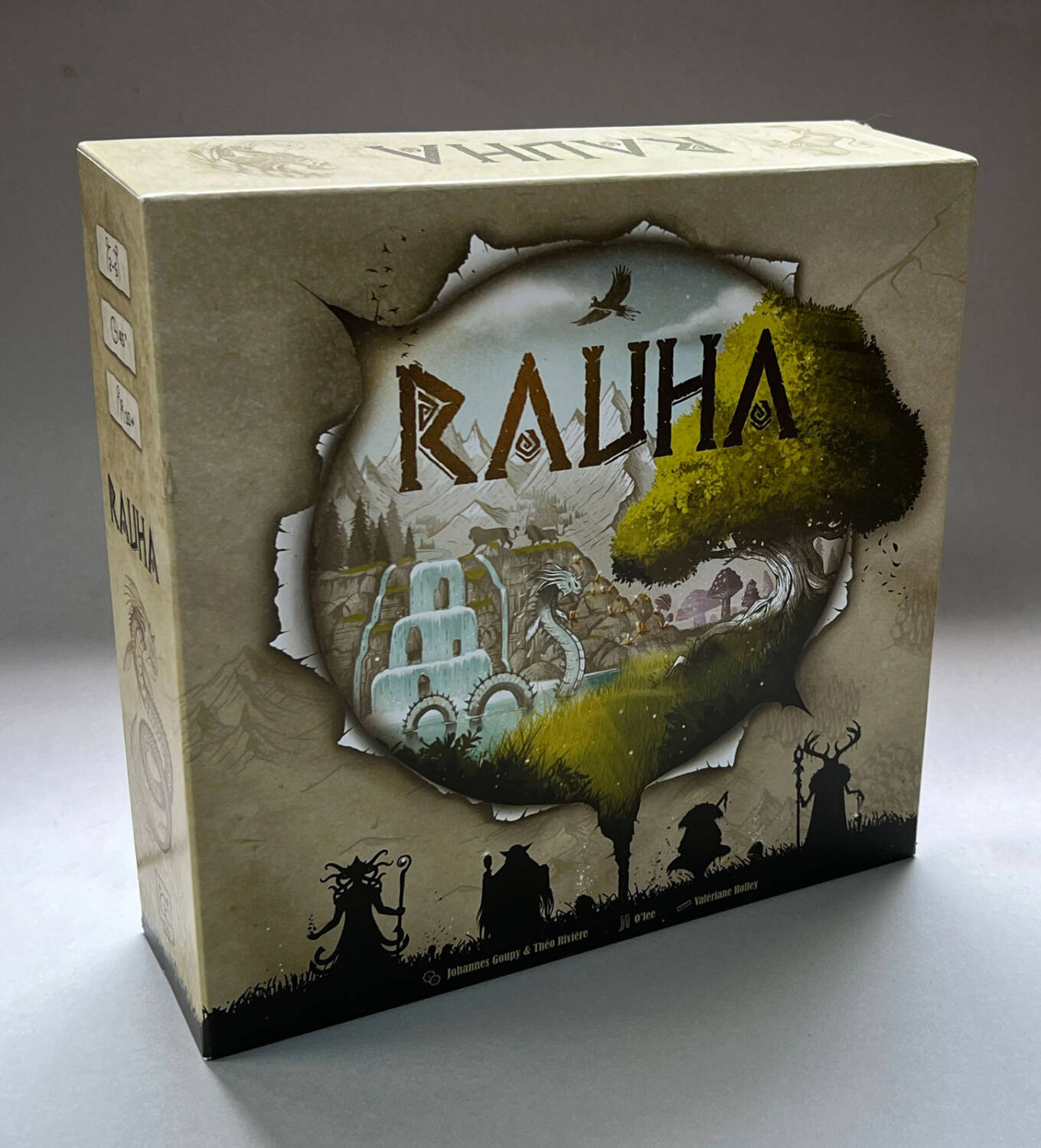
Setup
In the center of the table, place the central scoring board. Around the board place the two side pieces, and in those side pieces place the matching Divine Entity tiles.
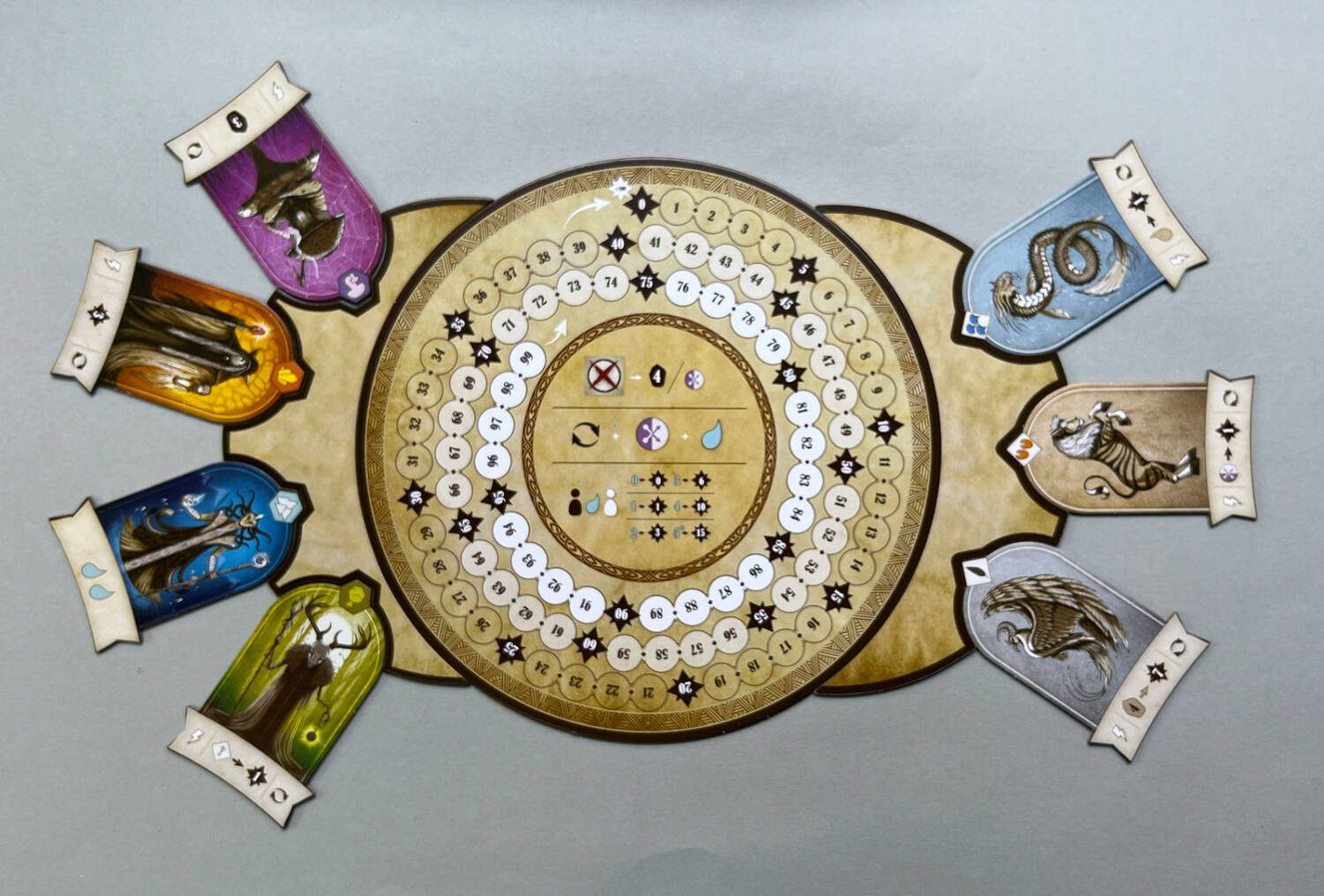
Each player takes the Energy Token and Avatar of their chosen color, as well as a common player board.
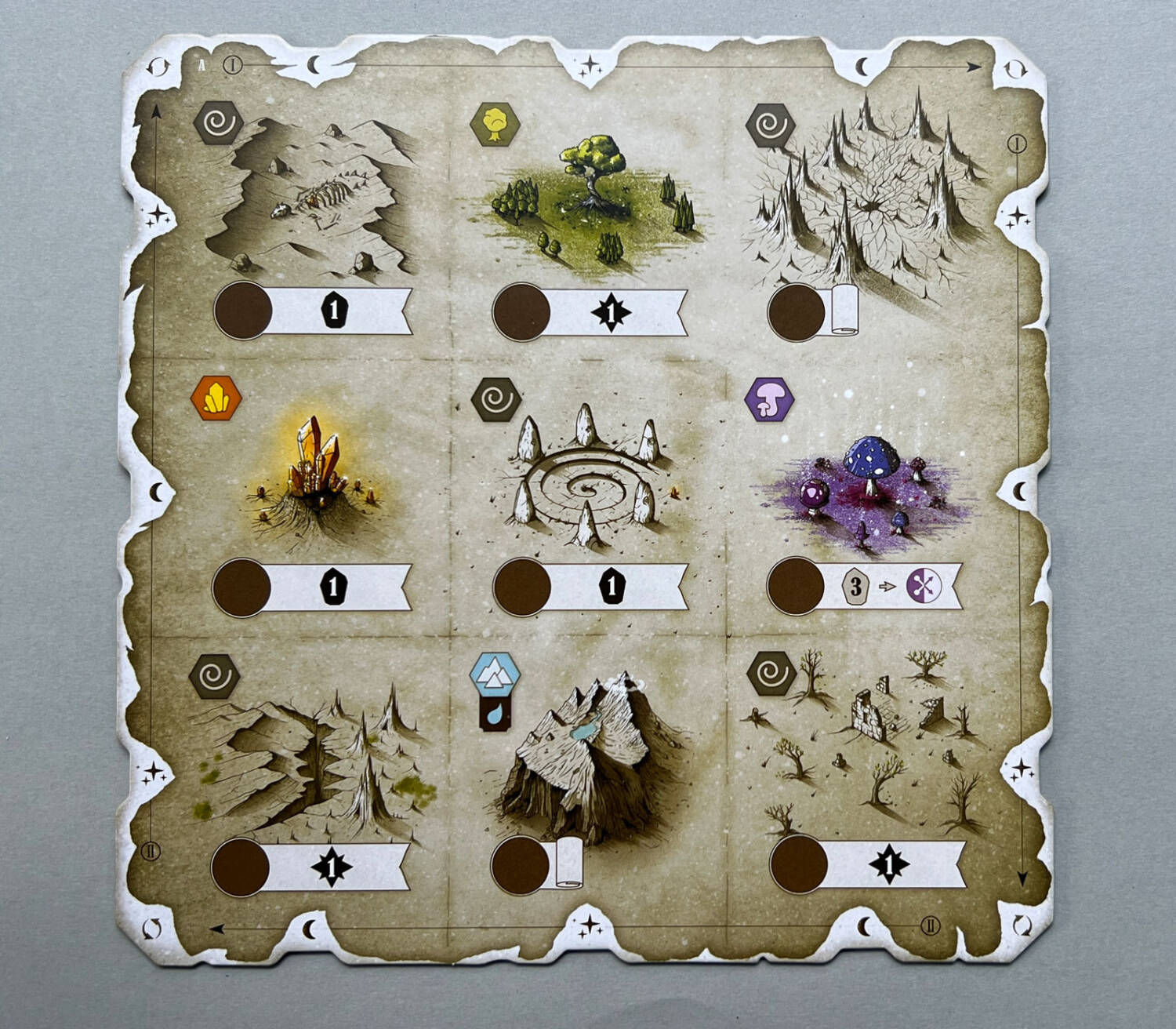
Their Energy Token goes on the starting spot of the central scoring board to track their Life Energy; their Avatar goes above the upper left square on their board, just above the moon icon. Give each player four crystals.
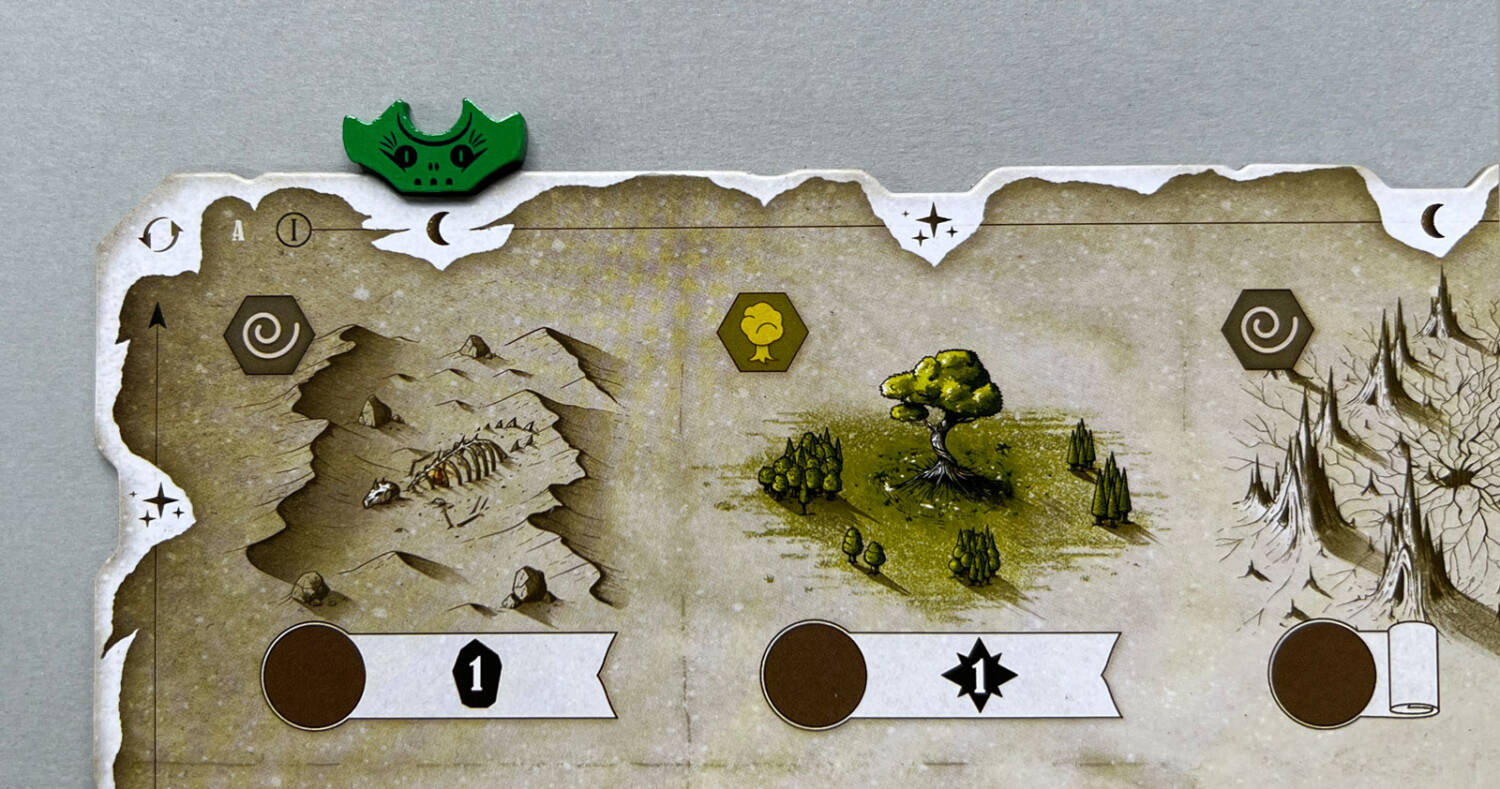
Set a satellite board between each pair of players, with the moon icon to their left and the star icon to their right. Set the Black Hole board off to the side. Set the purple spore pieces within easy reach of all players.
Shuffle the Age 1 Biome cards and deal four out onto each satellite board.
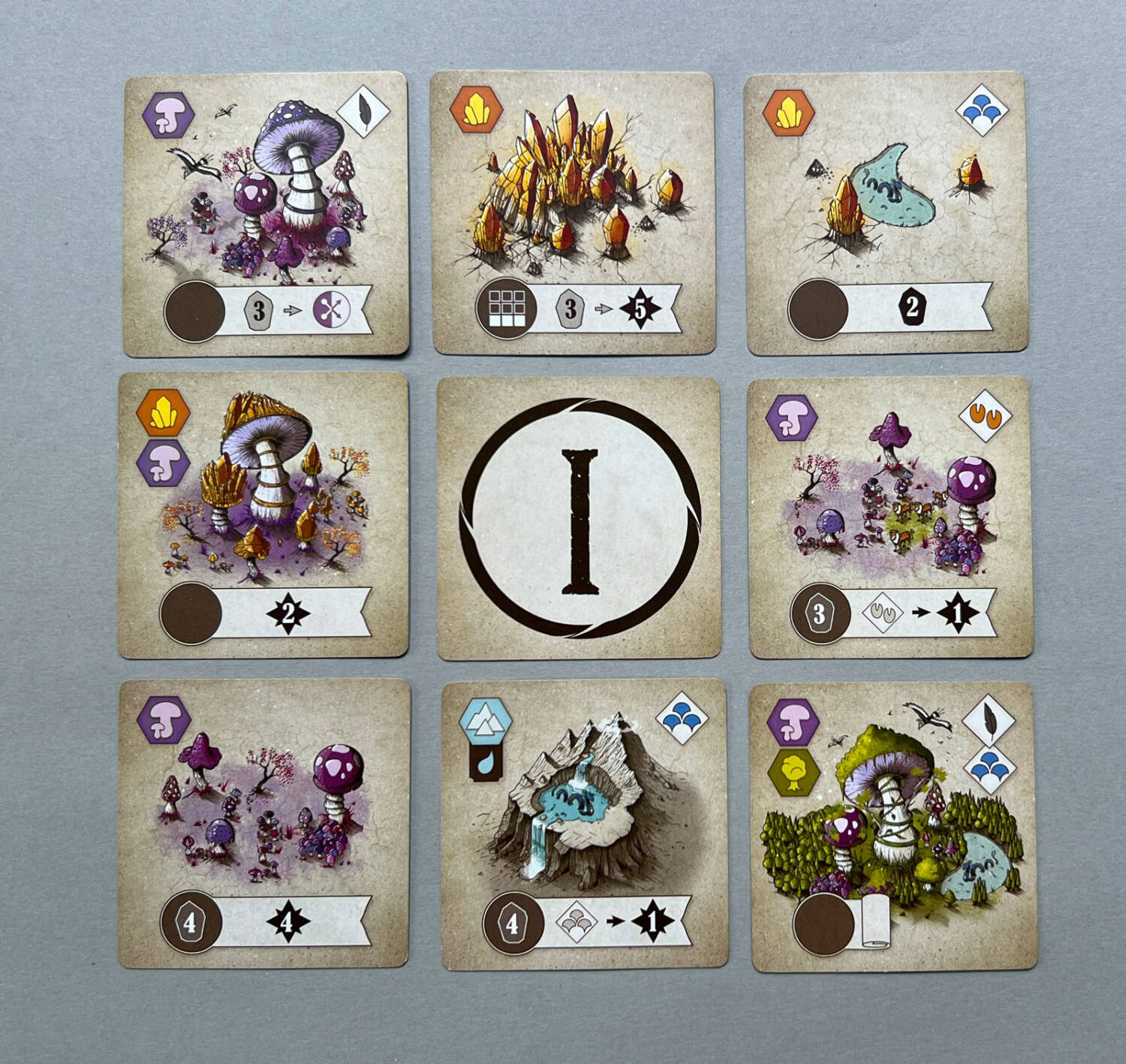
And you’re ready to play.
Playing the Game
On a turn, players will take a look at the icon along the edge of the board below their Avatar. This icon (either a moon or star) will remind you which satellite board you’re going to be taking cards from. The first icon is a moon, so you’ll take the cards to your left, choosing one, and placing the remaining cards back on the same satellite board.
Biome cards will have an environmental type in the upper left corner (forest, crystals, mushrooms, water) and may have an animal type (skies, earth, seas) in the upper right corner. Across the bottom will be a brown circle. If there’s a number in that circle, that’s the number of crystals you need to pay to place this Biome card on your board. If the scroll to the right of the circle is unfurled, this indicates potential bonus scoring that I’ll get to in just a few paragraphs.
If you choose to play a Biome card, you can place it anywhere on your 3×3 player board, even on top of other Biome cards you’ve previously placed. When placing Biome cards, you’ll be looking for how it will score on this and/or future rounds. You’re also going to try and create vertical or horizontal three-in-a-rows of any of the environmental or animal tags. Doing so will give you the matching Divine Entity tile during the corner scoring phase, which will grant you extra bonuses.
After placing your first Biome card anywhere on the board, you’ll then score the left-most column, the one under your Avatar. If you don’t cover up the pre-printed biomes on the common board, you’ll score 2 crystals and 1 point.
Scoring is done clockwise, starting with the first player (this changes to the player in the lead after the first turn). This is important due to a clever rule: if, for instance, let’s say Player One has three forest biomes in a row and claims the Forest Entity. Player Two then does the same, taking the Forest Entity from Player One and keeps it until someone else places three forest Biome cards in a row. In this way, Divine Entities can change hands multiple times before scoring is done, but only counts for the last player keeping the Entity.
After the first column has been scored, players move their Avatar to the space above the center column. That column has a star icon, indicating players take the remaining cards on the satellite board to their right to select their next Biome card.
Instead of playing a Biome card, you can send it into the Black Hole. Doing so will allow you to collect either four crystals or a spore.
Why collect spores? At the end of every third turn, an additional scoring round takes place. With Avatars placed at the corner of the board, players can score any Divine Entities they have as well as any of their Biome cards with a spore covering the brown circle. Given that each Biome will be scored a maximum of four times, spores allow you to score Biomes up to four more times.
During this additional scoring phase, players also count up the number of water biomes on their player board. The person who has the most water subtracts the number of water biomes held by the player with the least amount of water biomes and then scores points according to a chart provided on the scoring board.
After the second corner scoring has been completed, the First Age cards are replaced by the Second Age cards. These cards typically cost more crystals to buy, but have multiple biome types and/or animals on them.
And that’s the game. You’ll take a total of twelve turns (three on each of the four sides of the board), do standard scoring twelve times and ‘corner scoring’ four times. Final scores are tallied (with crystals and spores not counting towards points) and the highest score wins.
Thoughts
Let me start by saying Rauha is a fine light-to-medium weight game. My weekly gaming group requested we play this several weeks in a row as we grew in our understanding of how the game was played and how best to score. That being said, it’s fair to say they liked it more than I did.
There are several things about the game that I found frustrating, starting with the rule book. We here at Meeple Mountain play a lot of games. That means we read a lot of rule books. Occasionally, we find a rule book that’s so clear and easy to follow that we take to our Slack to tell everyone else about it. More often, though, we’re complaining about how poorly written rule books are. (Fellow Meeple Mountaineer and game designer, Gary Chavez, even wrote an article on how to write a good rulebook.)
One of the things that makes the rules for Rauha so difficult is their insistence on immersing an unfamiliar reader with their worldbuilding. While I appreciate the creativity that went into the theme of creating a diverse environment and attracting Divine Entities, I just want to learn how to play your game. In my Setup section, above, I left in all the names of the cardboard and wooden pieces to illustrate this point.
Rauha is actually an easy game to teach and play. You just have to get past the rulebook to realize that.
My biggest issue with Rauha, however, has to do with the ‘corner scoring’ of water. If the points scored between the person with the most water and the least water was equal to the difference of the two, that might work. However, the sliding scale used means a difference of 3 equals 6 points; a difference of 4 equals 10 points; a difference of 5+ equals 15 points. In a game of small scores over time, 15 points can be huge.
This forces players to adopt a water-based strategy throughout the game. If you see a water Biome card, you’re going to have to either buy it or toss it into the Black Hole (?) for a spore so your opponents can’t claim it.
In all our games, the winner has been the one who had the luck of the draw to get the most water Biome cards. They are that overpowered. For me, the game should have been called Waters of Rauha. Remove the extra water scoring and keep all biomes equal and I think the game would have been better.
On the positive side of things, the artwork is somewhat cartoony and good. (If you look carefully at each Biome card, you’ll see each of the environs and animals represented in the accompanying image.) The boards, Biome cards, and scoring track are all language-independent, as well as fairly color-blind friendly.
As I said, the members of my weekly group liked Rauha. It was requested several times and we were able to knock out a game in about an hour.
Rauha is a decidedly okay game. It’s one I’ll play if my group requests it again, but it’s not one I’m likely to suggest myself. I’d rather play a game that allows me to have greater agency in my decisions instead of forcing me down a single path to remain competitive.




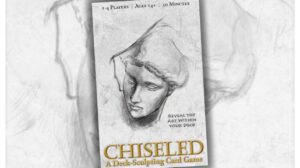






I played a lot Rauha games and water doesn’t always win. A full spore strategy with hooves multiplier is far better from my experience.